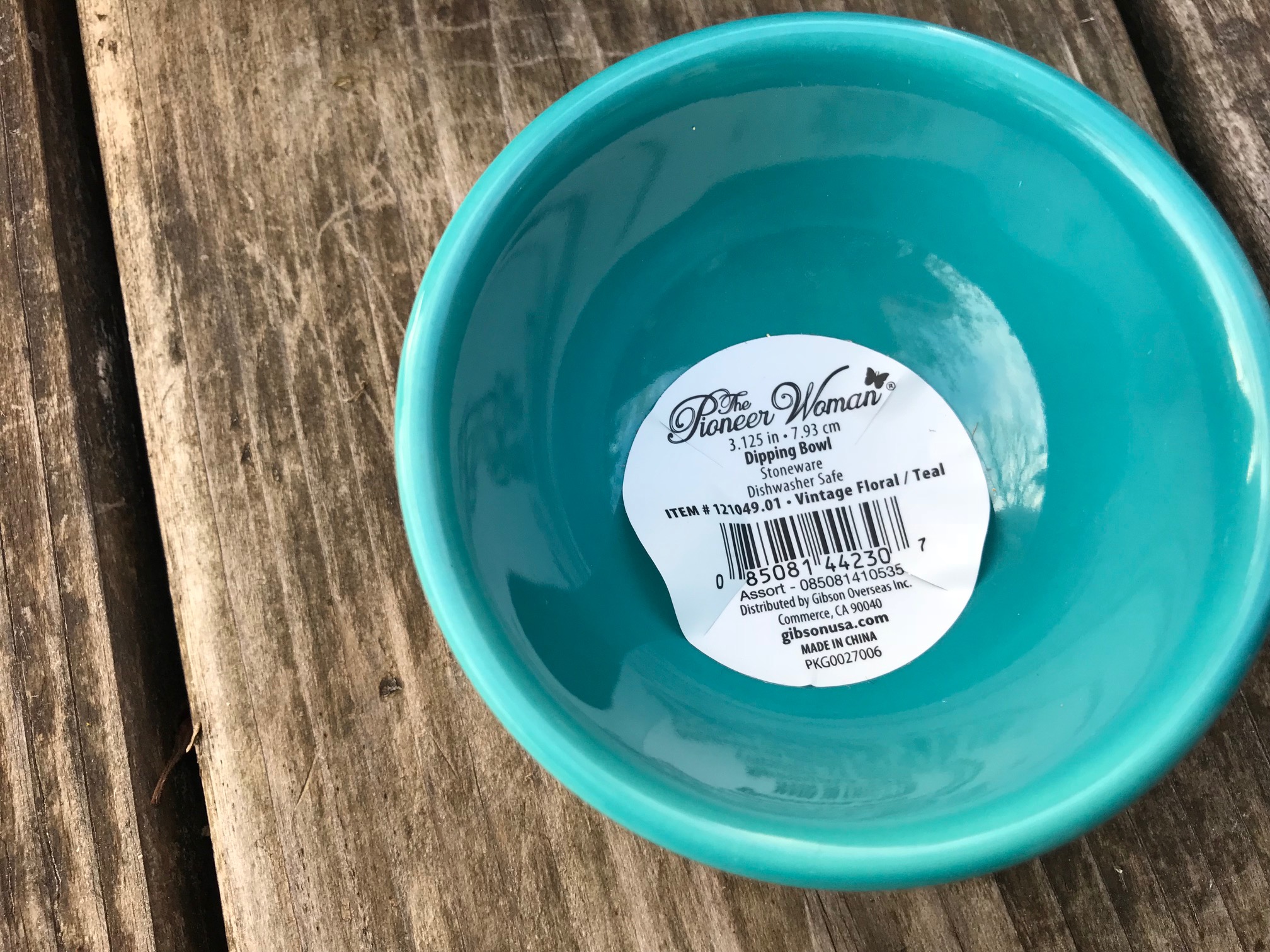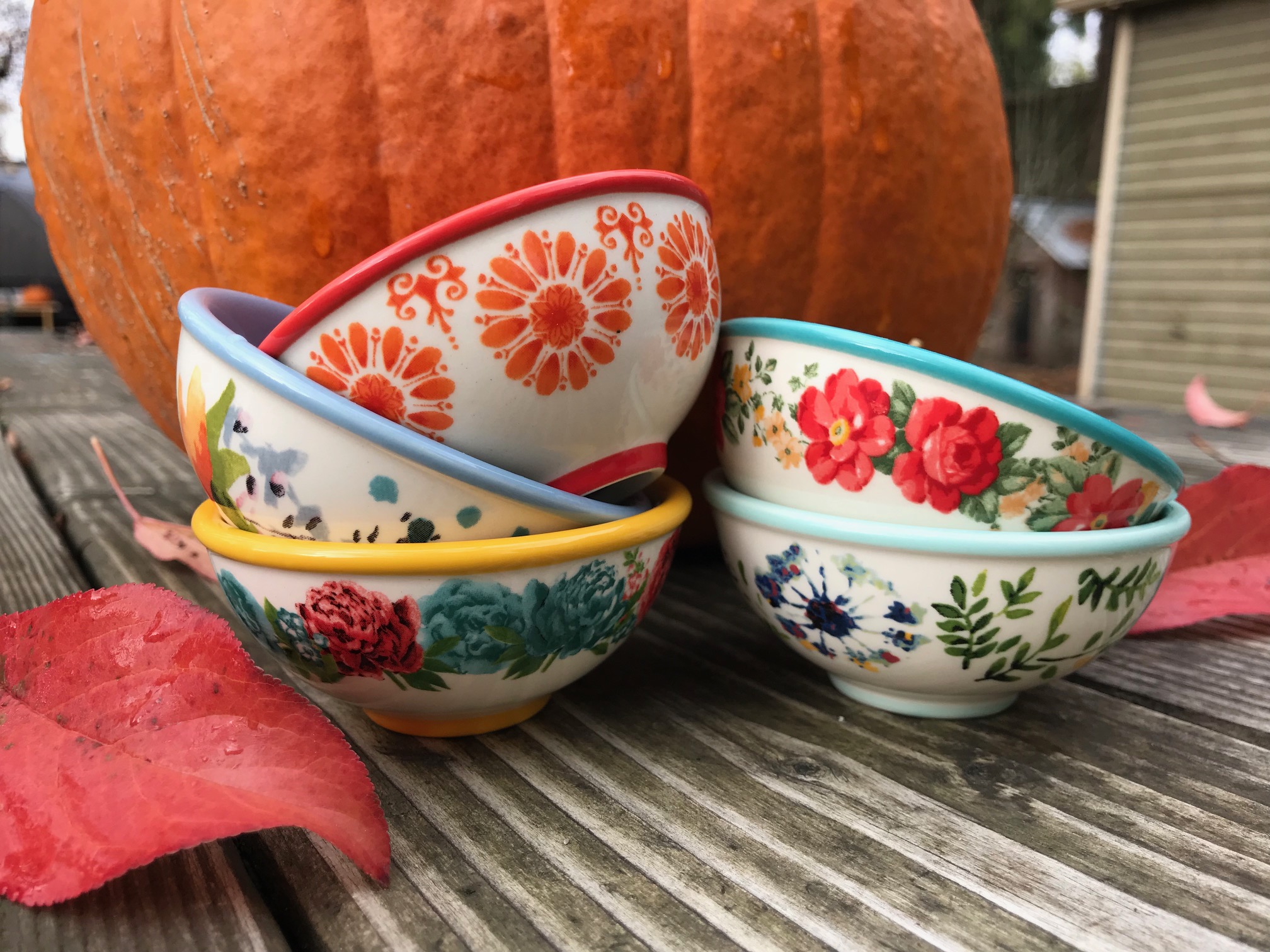Pioneer Woman “Vintage Floral” Teal Dipping Bowl: As high as 6,140 ppm Lead (90 ppm is unsafe in kids’ items)

“Vintage Floral” Teal Dipping Bowl pictured here.
To learn more about XRF testing, click HERE.
For those new to the Lead Safe Mama website:
Tamara Rubin is a multiple-federal-award-winning independent advocate for childhood Lead poisoning prevention and consumer goods safety, and a documentary filmmaker. She is also a mother of Lead-poisoned children (two of her four sons were acutely Lead-poisoned in 2005).
- Tamara owns and runs Lead Safe Mama, LLC — a unique community collaborative woman-owned small business for childhood Lead poisoning prevention and consumer goods safety.
- Since 2009, Tamara has been conducting XRF testing (a scientific testing method) using the exact instrumentation employed by the U.S. Consumer Product Safety Commission to test consumer goods for toxicants (specifically heavy metals — including Lead, Cadmium, Mercury, Antimony, and Arsenic).
- Since July of 2022, the work of Lead Safe Mama, LLC has been responsible for five product recalls (FDA and CPSC).
- All test results reported on this website are science-based, accurate, and replicable.
- Items that Lead Safe Mama, LLC reports on are tested multiple times to confirm the results published (for each component tested).
- Recent notable press… There has been too much to mention already in 2024! Please check out our press page to see some of the amazing coverage of our work so far this year!
For those who are new to my website: To better understand what the levels mean, please read the whole piece and click the embedded “click HERE” links for additional information. Thank you for reading!
Exterior Flowers
(based on a minute-long reading):
- Lead (Pb): 6,140 +/- 183 ppm
- Cadmium (Cd): 424 +/- 25 ppm
- Mercury (Hg): Non-Detect (nd) / Negative
- Arsenic (As): Non-Detect (nd) / Negative
- Barium (Ba): 320 +/- 68 ppm
- Chromium (Cr): 1,654 +/- 126 ppm
- Antimony (Sb): Non-Detect (nd) / Negative
- Selenium (Se): Non-Detect (nd) / Negative
- Zinc (Zn): 16,300 +/- 500 ppm
- Copper (Cu): 339 +/- 57 ppm
- Nickel (Ni): Non-Detect (nd) / Negative
- Iron (Fe): 2,884 +/- 265 ppm
- Bismuth (Bi): Non-Detect (nd) / Negative
- Vanadium (V): 467 +/- 57 ppm
- Titanium (Ti): 989 +/- 97 ppm
- Zirconium (Zr): 7,886 +/- 245 ppm
- Cobalt (Co): Non-Detect (nd) / Negative
To read more about Cadmium toxicity concerns, click HERE.
Click HERE to see this product on Amazon*.
Inside on Teal of Bowl (image above)
(based on a minute-long reading):
- Lead (Pb): 246 +/- 29 ppm
- Cadmium (Cd): Non-Detect (nd) / Negative
- Mercury (Hg): Non-Detect (nd) / Negative
- Arsenic (As): Non-Detect (nd) / Negative
- Barium (Ba): 813 +/- 83 ppm
- Chromium (Cr): Non-Detect (nd) / Negative
- Antimony (Sb): Non-Detect (nd) / Negative
- Selenium (Se): Non-Detect (nd) / Negative
- Zinc (Zn): 8,334 +/- 325 ppm
- Copper (Cu): 283 +/- 62 ppm
- Nickel (Ni): Non-Detect (nd) / Negative
- Iron (Fe): 850 +/- 197 ppm
- Bismuth (Bi): 56 +/- 22 ppm
- Vanadium (V): 1,781 +/- 292 ppm
- Titanium (Ti): 2,110 +/- 385 ppm
- Zirconium (Zr): 11,300 +/- 400 ppm
- Platinum (Pt): 208 +/- 94 ppm
To see the readings for this dipping bowl in other colors/ other patterns (plus the readings for the black and white logo), click HERE. I tested each of the bowls in the photo below and there is a separate piece listing the Lead and Cadmium levels for each design.
Tamara, what do these levels mean?
First and foremost, it is important to understand that I share this information with my readers primarily so they can make informed choices about what they have in their home and what they use to feed their families.
I try to avoid making the judgement calls for you. I rarely say things like “you shouldn’t ever use this.” Instead, I start my readers off on a path to learn as much as possible about the concern for toxicants (like Lead, Cadmium, Mercury, and Arsenic) in dishware so they can make their own decisions based on that information.
To give some context to the XRF test results listed above: The amount of Lead considered toxic in a new item manufactured and intended to be used by children (currently there are no equivalent U.S. regulatory standards governing items used by adults [!]) is anything 90 ppm Lead (or higher) in the glaze, paint, or coating. An XRF instrument may be used to determine the saftey of children’s items.
There is currently no U.S. regulatory standard (limit or restriction) for total Lead content in pottery and dishware as measured by an XRF instrument.
While these Pioneer Woman dipping bowls are not marketed for use by children, given their bright colors and diminutive size, one could easily see that a parent might give them to their child to play with, yet the CPSC does not normally address any concerns about the potential for off-label uses (like children using items only intended for use by adults) when it comes to Leaded items.
Given these are newly-manufactured and likely leach-tested (leach-testing is currently the sole U.S. testing standard used to determine potential toxicity for pottery and dishware), I do not have an immediate Lead-poisoning concern with a dish like this.
I do, however, have concerns over high levels of Lead in newly-manufactured pottery pieces when considering the potential for long-term heavy use and wear of items like this. Specifically, while the item may not be leaching now, how do we know it might not become a leaching hazard in 10 or 20 or 30 years — when our children are using these items (which we have passed on to them) with their children?
Separately, as an environmentalist and a parent, I also have concerns that these toxicants (Lead and Cadmium) are being used as glaze ingredients at all. The level of Lead found in these Pioneer Woman pieces specifically is definitely a level that would be considered an additive, not just a “contaminant.” (Lead is often added to glazes to enhance or stabilize certain colors.)
When a manufacturer chooses to use something like Lead intentionally as an ingredient, they are part of the larger problem because their manufacturing process creates a demand for the mining and refining of Leaded products, mining and refining processes which pollute our air, water, and soil, while exposing workers to this deadly neurotoxin.
Click HERE to read more about these concerns.
Thank you so much for reading and sharing about this work.
Please let me know if you have ANY questions.
Tamara Rubin
#LeadSafeMama
To make a contribution in support of Lead Safe Mama’s independent consumer goods testing (something we do that is wholly subsidized by readers chipping in!) please click HERE.
*Amazon links are affiliate links. If you purchase something on Amazon after clicking one of these links, Lead safe mama, llc may receive a small percentage of what you spend at no extra cost to you. Thank you for supporting our work in this way!
Never Miss an Important Article Again!
Join our Email List












The title should read, “Pioneer Woman Vintage Floral / Teal Dipping Bowl: as high as 6,323 ppm Lead”, because 6140+13=6323.
Yes – that’s right! Thank you. The margin of error is 183, so 6140 +183! 6,323
I’m curious as to how you converted an XRF instrument reading into ppm. I have used portable XRF instruments in my job as a Certified Industrial Hygienist and they read out in mg/cm2 or ug/cm2 (mass per unit area), not in ppm. We use them to test for lead in paint on a substrate, typically metal or wood. You would have to scrape off some of the glaze or color pigment and have a lab analyze it to obtain an accurate ppm concentration. Regardless, I do agree that any container used for food should not contain lead or cadmium. Lead-free in China is not necessarily defined in the same way it is in the U.S. by the Consumer Product Safety Commission (CPSC).
Hi Bob! Good question. Most handheld XRF instruments cost in the $10,000 to $20,000 range new. I use a Niton XL3T that is specifically designed to test consumer goods (and metals and soils, etc.) and has software modules to do that. These modules give readings in PPM. It is a non-radioactive source instrument (so a radiation safety monitoring badge is not necessary for operation) and generally this type of instrument costs in the range of $35,000 to $50,000 new – depending on what software modules you have installed. My understanding from conversations with Niton a few years ago was that the NEW (upcoming) XL5T was going to be about $50,000 before the software packages were installed – although I don’t know if that model ever has been deployed with the consumer goods software module… I’ve been waiting to hear about that! In the meantime you can get a Niton XL3t used (with the full software range installed – if you can find one) for something in the range of $30,000 to $35,000 and it is the same instrument used by the CPSC to do testing of consumer goods in ppm.
Where do we throw these out? And what is safe to use?
Now I am concerned about my make-up.
Who needs garbage? And those poor workers 🙁
I have dealt with endometriosis, thyroid issues ..no bad stuff, thanks
You should be worried about your makeup for a lot of reasons but you will never hear it from the government. There are safe alternatives.
Is it only the pioneer woman teal dipping bowl?
What about the dinner plates, salad plates , cereal bowls, coffee mugs?
What about all other pioneer woman dinnerware other than the real color?
Hi Heather,
Here are all of the Pioneer Woman posts on the blog so far – I think you could extrapolate the concern to all of their colorful ceramic products: https://tamararubin.com/category/pioneer-woman/
Thank you for commenting!
Tamara
If the bowl had that much lead and cadmium, is there an above average chance that the THE PIONEER WOMAN VINTAGE FLORAL TEAL 16OZ MUG SET, SET OF 4 that are for sale right now, also do?
The mugs are white (cream) inside, and have teal blue/green outside plus flowers and leaves.
Hi Linda – probably likely but not 100% certain (perhaps they saw my original post and made manufacturing changes? #WishfulThinking!)
Thank you for commenting!
Tamara
I have this exact set of finger bowls in my home. I purchased them in recent years. I am shocked such items are for sale in Walmart right now. How do we keep ourselves safe? I am positive I have other Walmart pioneer women pieces if I look around. I am so upset about this. Thank you for sharing this information. I wondering what to do. I am sure Walmart is aware and does not care.
Does Pioneer Woman herself know these results, yet keeps on sending them out to the public? All about $$$. I guess money is more important than the health of her public. Shame on her.